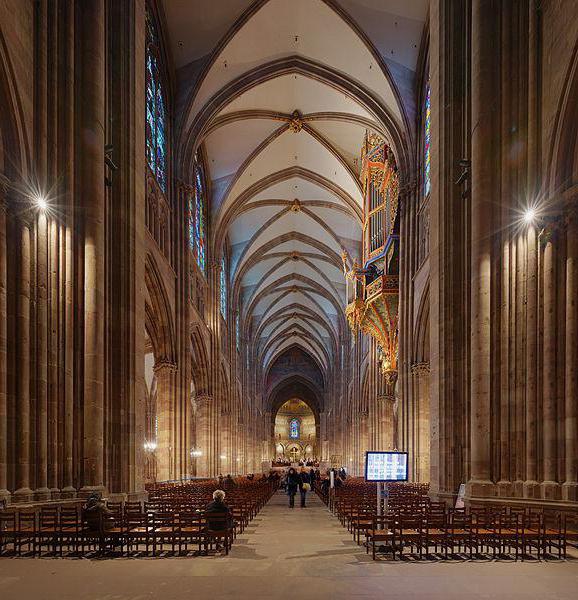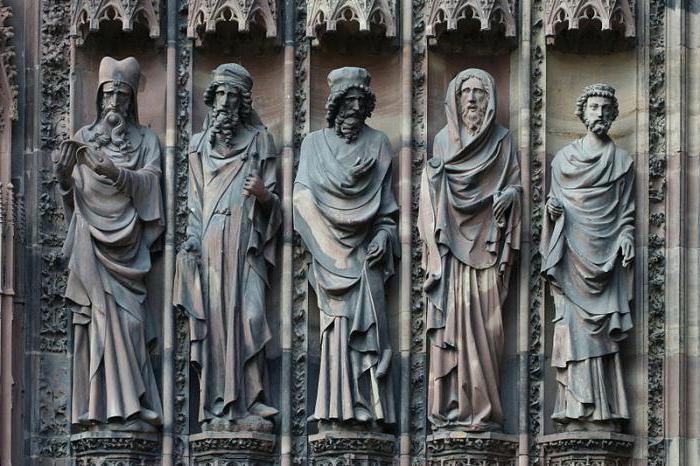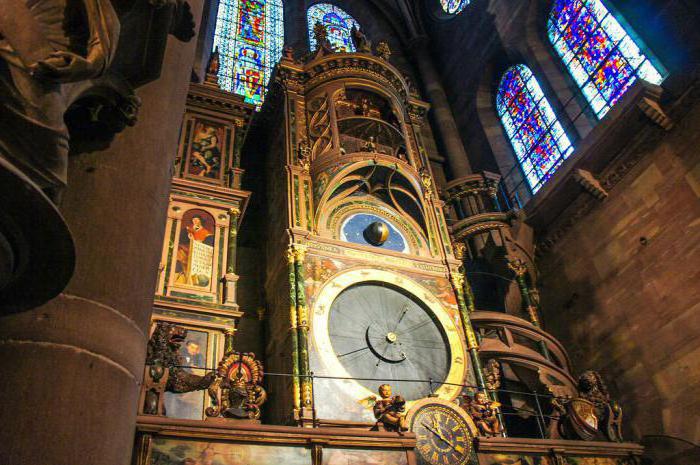Goethe called it “the exalted tree of God,” and Victor Hugo called it “a giant elegant miracle.” All these poetic epithets describe the cathedral in Strasbourg - the city of France bordering Germany. For two centuries, this building was the tallest in the world. The spire of the cathedral is visible far beyond the borders of Strasbourg. Its silhouette against the backdrop of a reddening sunset sky is the hallmark of the city. The spire is visible even from the other side of the Rhine, along which the modern border passes. Therefore, the Strasbourg Cathedral in Germany is considered almost their own (taking into account the history of Alsace and Lorraine). This church is both majestic and elegant. Even in the twenty-first century, the era of skyscrapers, Notre Dame Strasbourg ranks sixth in the world in height among temples. She also holds leadership as the largest building of such a short-lived stone, like sandstone. Let's take a virtual tour of this unique Gothic temple.

How to get to Strasbourg Cathedral
It is not difficult to find this structure - the 142-meter tower is visible from afar. But the center of Strasbourg was erected on an island surrounded by the river Ile. A dense half-timbered building with overhanging balconies along narrow medieval streets closes the view. There are so many interesting sights around that it is just right to forget where you intended to come. Strasbourg Cathedral suddenly appears in all its glory in the narrow opening of Mercier Street. You can get to it by crossing the bridge over the Vieux Marsh Oaks Poisson (near the Historical Museum). Take pictures of him from this position. If you come closer, you can capture only fragments of the facades, but not the whole giant-beauty. By the way, on the right side of Mercier street is the old half-timbered house of Kammerzel (XV century), decorated with wooden sculptures - now there is a large souvenir shop.
Strasbourg Cathedral: History
Modern Alsace was once part of the immense Roman Empire. Therefore, it is not surprising that a pagan temple stood in the very center of the Gallic settlement of Argentoratum. Much later, Strasbourg got its modern name from two German words: “Strasse” - a road and “Burg” - a castle or fortified city. When Christianity became the dominant religion, the pagan temple was destroyed, and in its place began to build a church. About a thousandth year, the population of Cities on Roads has grown so much that the need arose for the cathedral. The first stone in the building was laid by Bishop Werner of Habsburg in 1015. Naturally, the layout was a typical Romanesque cathedral. The fire of 1176 destroyed the wooden roof and upper floors. Therefore, it was decided to build a cathedral of stone. He was brought from the nearest mountains - the Vosges. This sandstone has an amazing ability to shine pink at sunset or sunrise.
Strasbourg Cathedral (France) and Episcopal Vanity
Gothic was in fashion in the thirteenth century. The cities of Western Europe competed among themselves who would build the tallest, largest and most beautiful House of God. The bishops of Strasbourg were harassed by the laurels of his Basel, Ulm and Cologne colleagues. Therefore, he did not spare money to write out the most fashionable (and highly paid) architects to build his cathedral. Of course, he did not wait for the end of the work and did not see the magnificent creation. After the death of the bishop, the municipality paid for the construction - consuls and ordinary townspeople. It so happened that the eastern and southern portals, as well as the choir, are made in the Romanesque style, and the western part with the north tower is in the Gothic. By the way, the plan provided for the construction of his one southern spire. But the city simply did not have enough time for it. The asymmetry of the design also makes it unique. A 142-meter north tower was completed only in 1439.

Western facade
We are not in a hurry to go inside. The unchanging ritual of all tourists is a leisurely and thoughtful walk around the majestic building. Strasbourg Cathedral in France is famous for its western facade. This is a true masterpiece of high Gothic. One of the architects was Erwin von Steinbach. He in 1284 and designed the western facade, with a thousand sculptures and an elegant rosette window. When there was not enough money for the construction, the architect sold his horse and donated the necessary amount. In the fourteenth century, the main architect was Ulrich von Ensingen, the creator of the cathedral in Ulm. And the famous North Tower was completed by Johann Hultz - a master from Cologne. Thousands of stone sculptures and ornaments adorning the western facade of Strasbourg Cathedral are included in all textbooks on medieval Gothic. Wonderful stained-glass windows are best viewed from the inside. They were taken away by the Nazis during the last World War, but later the German government returned them along with stolen tapestries and paintings.

Facade of the South Traverse
Strasbourg Cathedral should be bypassed entirely. Not only the tall spire and the richly decorated with sculptures western facade attracts attention. The south traverse with the entrance is also very interesting. It is decorated with the no less famous sculptural group “Church and Synagogue”. During the crusade against the Albigensians, this plot was reinterpreted as the struggle of the Roman Papacy with dissident Christian beliefs. Gargoyles serving as rain gutters seem to say: "There is no Salvation outside the Catholic Church." In the Gothic facade on the triple portal of the main entrance we see a scene of worship of the Magi. There are sculptures of Old Testament prophets and New Martyrs. Allegorical figures depict Sins and Virtues.
Interior Attractions
And now we will go inside the cathedral, especially since the entrance to it is free. The Strasbourg Cathedral continues to fulfill its functions as an existing church, therefore, during services, tourists are not allowed to enter it. Inside the church is decorated no less luxuriously than on the outside. It's good to come here on a sunny day - then the stained-glass windows look especially impressive. What you need to not miss in the Strasbourg Cathedral? This is a baptismal font created in the mid-fifteenth century by sculptor Dotzinger. Tapestries, paintings on religious subjects, an ancient organ attract attention. The pulpit is very beautiful, decorated with numerous statues belonging to the cutter of Hans Hammer. You also need to look into the limit of St. Lawrence and see the picture of Nicolas Raeder (in the northern transept).
Tower
Be sure to climb the spire that crowns the Strasbourg Cathedral. Strasbourg from the observation deck - in full view. In addition, you can see some sculptures and gargoyles nearby. If it will be difficult to climb a narrow spiral staircase, remember: these steps were overcome by Stendhal and Goethe. And the latter did this daily while studying at the University of Strasbourg. So he recovered from a phobia of height. This spire until the eighteenth century (until the completion of Cologne Cathedral) remained the highest construction. It is noteworthy that during the French Revolution they wanted to destroy the bell tower. Say, she leveled the principle of equality. But the locals adorned it with a Phrygian cap (a symbol of freedom), and the ideological intensity of the revolutionaries was removed. Entrance to the tower is paid: 4.5 euros for an adult and 2.5 for children and students.
Astronomical clock
If you buy a ticket to the North Tower, you can also visit the choirs that go along the upper tier of the entire cathedral. This will give you a unique opportunity to take a closer look at the stained glass windows and beautiful Gothic rosettes. But in the temple there is another paid attraction for tourists. This is the astronomical clock of Strasbourg Cathedral. The third chronometer was improved and installed in 1832. Before him, watches with astronomical functions have faithfully served the city since 1574. The first chronometer has been mentioned since 1353. What is interesting about the clock in Strasbourg Cathedral? The complex mechanism shows the orbits of the Earth and the Moon, as well as all the planets known at that time. In addition, on New Year's Eve, the clock makes a full turn and shows the dates on which the "floating" Catholic holidays fall (Easter, Ascension, Pentecost). The gear of the mechanism that rotates most slowly is responsible for determining the precession of the earth's axis. It will make a full revolution (if, of course, the chronometer survives) in twenty-five thousand eight hundred years.

Events
Strasbourg Cathedral has always played a key role in the life of the city. Not only are liturgies held here. On Sundays, in the morning, in the cathedral you can listen to the Gregorian chapel. Very often organ concerts are held here, in which an old, richly decorated instrument is involved. It is especially good to come to Strasbourg in the summer. Firstly, the weather promotes walks and sailing along the canals on boats. In the cold season, they also run, but their top is glazed. As a bonus, summer tourists are given the opportunity to see a beautiful sight. Every evening, various concerts are held in the square in front of the cathedral. Many floodlights illuminate the walls of the majestic building in time with the music, making the statues on the facades seem to come to life.
City and its attractions
Strasbourg Cathedral is a kind of dominant. But on it the tourist attractions of the city are not exhausted. Of course, it is necessary to begin acquaintance with Strasbourg from its cathedral. Reviews of tourists are especially recommended not to be too lazy and climb the tower. This will give you a visual representation of the location of the city, which means that it will be possible to draw up a route for further excursions. Must visit the bishop's palace, the quarter "Little France", the Museum of Alsace. Do not forget that the European Court of Human Rights is located in Strasbourg . This newest building is not located in the city center, and it is best to get there by tram. Reviews of tourists strongly recommend, regardless of the season, to take a sightseeing boat along the canals of the Ile River with their many gateways.